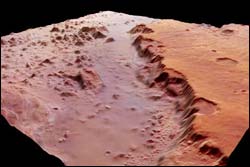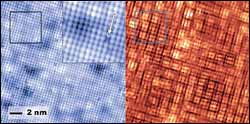This area deals with the fundamental laws and building blocks of nature and how they interact, the properties and the behavior of matter, and research into space and time and their structures.
innovations-report provides in-depth reports and articles on subjects such as astrophysics, laser technologies, nuclear, quantum, particle and solid-state physics, nanotechnologies, planetary research and findings (Mars, Venus) and developments related to the Hubble Telescope.

These images, taken by the High Resolution Stereo Camera (HRSC) on board ESA’s Mars Express spacecraft, show the southern part of Valles Marineris, called Eos Chasma.
The images were taken during orbit 533 in June 2004, and are centred at Mars longitude 322° East and latitude 11° South. The image resolution is approximately 80 metres per pixel.
Between surrounding plains and the smooth valley floor, a height difference of about 5000 metres has been measured. The plain to the sout

Most miniature electronic, optical and micromechanical devices are made from expensive semiconductor or ceramic materials. For some applications like diagnostic lab-on-a-chip devices, thin-film polymers may provide a cheaper alternative, but the structure and properties of these materials—-often no more than a few nanometers (nm) thick—-are difficult to determine. In addition, defects in the thin polymer masking materials used to “print” integrated circuits can produce malfunctioning components.

University of Chicago scientists have solved a 20-year-old puzzle in particle physics using data from an experiment conducted for an entirely different purpose.
Physicists had long known that something was amiss regarding their understanding of how some quarks interact in the beta decay of particles, a common form of radioactivity. Either dozens of experiments conducted over a period of more than three decades were wrong, or the scientists’ theories were. Now, in a set of four

ESO HARPS Instrument Discovers Smallest Ever Extra-Solar Planet
A European team of astronomers [1] has discovered the lightest known planet orbiting a star other than the sun (an “exoplanet”).
The new exoplanet orbits the bright star mu Arae located in the southern constellation of the Altar. It is the second planet discovered around this star and completes a full revolution in 9.5 days.
With a mass of only 14 times the mass of the Earth, the new planet lies at th

The importance of characterising the atomic structure of the silicon / silicon dioxide interface as an essential component in highly integrated circuits has steadily increased as a result of continuing miniaturisation of silicon chips. The physicists, Dr. Stefan Bergfeld, Bjoern Braunschweig and Prof. Dr. Winfried Daum, Institute of Physics and Physical Technologies at the Technical University of Clausthal, have succeeded in characterising the change in bond structure of interfacial atoms during the

With equipment so sensitive that it can locate clusters of electrons, Cornell University and University of Tokyo physicists have — sort of — explained puzzling behavior in a much-studied high-temperature superconductor, perhaps leading to a better understanding of how such superconductors work.
It turns out that under certain conditions the electrons in the material pretty much ignore the atoms to which they are supposed to be attached, arranging themselves into a neat pattern